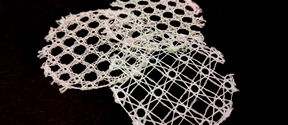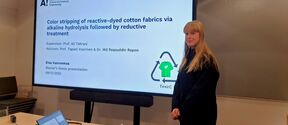The rebirth of pulp

The black lampshade has an exciting, rough surface. It looks light, but even a sharp blow won't shatter it. The shade was created after design student Natalie Mussi-Weidlich took a fancy to a bowl she saw in a laboratory last summer and came up with the idea of casting very thin layers of nanocellulose over it.
Nanocellulose is made by chopping regular pulp fibre into very small pieces. The pulp loses its wood-like properties on the nanoscale and the resulting substance is like nature's very own fortifier and play-dough, a material that makes it possible to build very light and strong structures. This wonder material has been the focus of research for years, but it is unlikely that Natalie would have gotten her hands on any were it not for Professor of Wood Chemistry Tapani Vuorinen, who decided to leap out of his comfort zone four years ago.
Start with nothing
Back in December 2011, Vuorinen was dealing with a bad case of the nerves. Helena Hyvönen, the then Dean of the School of Arts, Design and Architecture, had asked him to give a speech about a familiar subject, but to an unusual audience.
“Helena wanted me to talk about cellulose at the Fashionable technology seminar. The idea worried me. I wondered why my words would interest people in the fashion industry, but I actually received a very enthusiastic reception,” he recalls with a smile.
The seminar is also where Tapani Vuorinen met with then Professor of Textile Design Pirjo Kääriäinen. Their encounter soon led to the birth of the idea to bring together students from two schools to come up with new forms of cooperation.
Outi Krause, who at the time was Dean of the School of Chemical Technology, also liked this idea and the first CHEMARTS summer school was arranged the next summer.
“The start was so exhilarating. Traditionally, the textile industry and the pulp and paper industry have stuck to their own turf rigidly, until Helena and I all of a sudden realised that Otaniemi in fact had a pulp processing line that we could almost think of as ours,” Pirjo Kääriäinen laughs and stresses that the strength of CHEMARTS has, from the very beginning, resided in the students. They are not assigned prepared problems to solve; instead, participants start from nothing and themselves think up what is interesting and significant.
“Chemical technology research projects are often very narrow and their goal is clearly defined in advance. Now, no-one knows what they're supposed to do in the beginning, and fresh ideas emerge from the work,” Tapani Vuorinen adds.
Edible dishes and decomposable shoes
Lectures and workshops precede the summer school, which has produced a number of inventive products and insights over the years. Last summer, for example. Senja Smirnova and Zhen Zeng sketched out a new approach to the colour removal that recycled fibres require.
Instead of trying to remove colour from fibres with chemicals, retained colour is taken as a starting point for a new product. This makes colour removal and re-dying completely unnecessary and reduces the need for chemicals, Kääriäinen says and enthusiastically lists other student-produced fresh ideas: edible dishes made from bacterial cellulose and bark bread by Maija Järviniemi and Outi Mustonen as well as Laura Niemelä's antibacterial and antiperspirant pine needle extract that also has water-repellent properties.
“You can only admire the multi-layered thinking of these students,” Tapani Vuorinen says.
“The summer before last, they made shoes that utilised pulp in many different ways. They embedded birch seeds in the soles and when the shoes finally decompose at the end of their lifecycle, these seeds end up in soil where they'll sprout new trees.”
The strength of science lies in a profound understanding of the details, while design leans on identifying human needs and producing solutions in response. This is why Vuorinen and Kääriäinen emphasise how important it is for experts of different fields to really work together and share their expertise already in the early stages of their studies.
“Take cellulose, for example,” Pirjo Kääriäinen observes.
“It's a challenging material because it bends when it dries. But instead of trying to straighten it, designers can employ knowledge of its natural tendency to form double-curved shapes when designing products.”
Good for people, good for the planet
From the start, CHEMARTS was given the freedom to grow and develop free from external pressure. The effectiveness of this cooperation was quickly noticed and it received substantial research funding from Tekes as part of the Design Driven Value Chains in the World of Cellulose project in 2013. Last year, it was admitted to the EU-funded Trash to Cash consortium, which looks for ways to process textile waste into high-quality products. All activities have one goal: the promotion of sustainable development.
“All of us will have to take it into consideration in our everyday lives soon,” Kääriäinen stresses.
“The world is not transforming into something digital. Now and in the future, we'll need clothes, homes and a built environment. How and from what these are made from and how we handle recycling will become more and more critical. We need to get the circular economy going for real.”
Cellulose is an excellent fit for sustainable development and the circular economy. It is the world's most abundant renewable resource, in addition to which it is recyclable and biodegradable, as long as excessive chemicals are not added during processing.
“We want to replace plastic and cotton, which consumes lots of farming land and irrigation water, with cellulose; this is a pretty good point of departure for CHEMARTS,” Pirjo Kääriäinen sums up.
Aalto has, in cooperation with VTT and the University of Helsinki, developed the Ioncell-F process, which can be used to recover high-quality textile fibre in an environment-friendly manner from cellulose, recycle cardboard and cotton waste. Challenging plastic still calls for a lot of research, however, because the properties of cellulose must be adapted for a number of different end uses.
“We need to discover how to prevent cellulose products from degrading in water and how to make them gas impermeable,” Tapani Vuorinen says.
“This is very important because plastic is a real environmental problem. It decomposes into particles so small that it can, for example, enter the very smallest organisms in oceans and can even penetrate cell membranes.”
Kääriäinen points out that a material, which is harmless to the planet, will also be good for people.
“Cellulose-based fibres feel great,” she says while stroking her jumper.
“The textile industry is one of the world's biggest industrial sectors. It consumes enormous amounts of a material, which grows all over the place in Finland. There's plenty of opportunities here, as long as we keep in mind that an industry which withered away decades ago won't come back as it was, but must instead be reborn first.”
CHEMARTS will expand into an independent and permanent minor studies totality, which is open to all Aalto University student, in the next academic year.
Pirjo Kääriäinen and Tapani Vuorinen (centre) are in charge of
the multidisciplinary CHEMARTS project. Master's degree
student Laura Niemelä and PhD student Andreas Lindberg from
the School of Chemical Technology also work at the lab.
Text: Minna Hölttä
Photos: Aki-Pekka Sinikoski
The original article is published in the Aalto University Magazine issue 16.
Read more news

Learning Centre opening hours during Christmas and year-end holidays
Thank you for the past year and have a wonderful holiday season!
Smart textiles are reshaping our understanding of materials – and interspecies communication
The PAST-A-BOT research project, funded by the European Research Council (ERC), is developing soft, intelligent textiles that could one day function as rescue robots, sound-sensing agricultural fabrics, or assistive clothing. At the same time, the project aims to rethink the way we approach materials research.
Master’s student showcases efficient color stripping of cotton fabrics
On December 9, master’s thesis student Elsa Vuorenmaa from the Textile Chemistry Group presented the results of her research on color stripping of reactive-dyed cotton fabrics.






